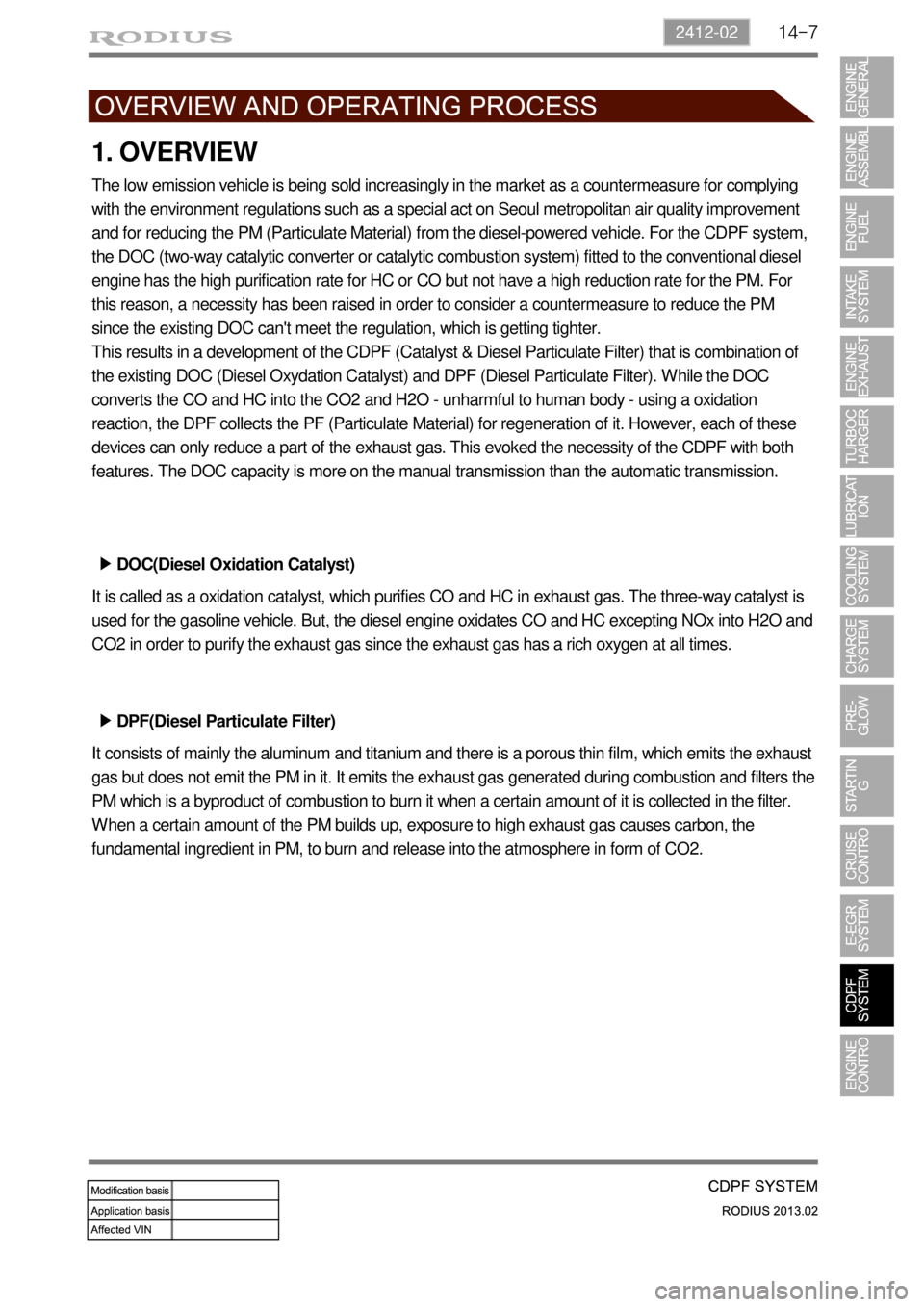Page 304 of 796
12-58510-23
2. HOW TO OPERATE CRUISE CONTROL SWITCH
1) Setting a Desired Speed
To operate the cruise control, accelerate to the desired speed, which must be more than 36 km/h
(23 MPH) and less than 150 km/h (90 MPH).
When the desired speed is reached, push up the ACCEL switch of the cruise control lever or push
down the DECEL switch for 1 second per one switching and then release the accelerator pedal
slowly.
Now, the vehicle is cruised by this system with the set speed.
And you can set to other vehicle speeds again with above steps after an accelerator pedal
intervention during the cruise control running. 1.
2.
3.
4.
Never use the cruise control system until you get used to it.
Improper use or not fully aware of this function could result in collision and/or personal injuries.
(1) Manual transmission equipped vehicle
The cruise control is only available when the 3rd or higher speed gear is engaged.
Page 319 of 796

14-72412-02
1. OVERVIEW
The low emission vehicle is being sold increasingly in the market as a countermeasure for complying
with the environment regulations such as a special act on Seoul metropolitan air quality improvement
and for reducing the PM (Particulate Material) from the diesel-powered vehicle. For the CDPF system,
the DOC (two-way catalytic converter or catalytic combustion system) fitted to the conventional diesel
engine has the high purification rate for HC or CO but not have a high reduction rate for the PM. For
this reason, a necessity has been raised in order to consider a countermeasure to reduce the PM
since the existing DOC can't meet the regulation, which is getting tighter.
This results in a development of the CDPF (Catalyst & Diesel Particulate Filter) that is combination of
the existing DOC (Diesel Oxydation Catalyst) and DPF (Diesel Particulate Filter). While the DOC
converts the CO and HC into the CO2 and H2O - unharmful to human body - using a oxidation
reaction, the DPF collects the PF (Particulate Material) for regeneration of it. However, each of these
devices can only reduce a part of the exhaust gas. This evoked the necessity of the CDPF with both
features. The DOC capacity is more on the manual transmission than the automatic transmission.
DOC(Diesel Oxidation Catalyst) ▶
It is called as a oxidation catalyst, which purifies CO and HC in exhaust gas. The three-way catalyst is
used for the gasoline vehicle. But, the diesel engine oxidates CO and HC excepting NOx into H2O and
CO2 in order to purify the exhaust gas since the exhaust gas has a rich oxygen at all times.
DPF(Diesel Particulate Filter) ▶
It consists of mainly the aluminum and titanium and there is a porous thin film, which emits the exhaust
gas but does not emit the PM in it. It emits the exhaust gas generated during combustion and filters the
PM which is a byproduct of combustion to burn it when a certain amount of it is collected in the filter.
When a certain amount of the PM builds up, exposure to high exhaust gas causes carbon, the
fundamental ingredient in PM, to burn and release into the atmosphere in form of CO2.
Page 410 of 796
10-58510-23
2. HOW TO OPERATE CRUISE CONTROL SWITCH
1) Setting a Desired Speed
To operate the cruise control, accelerate to the desired speed, which must be more than 36 km/h
(23 MPH) and less than 150 km/h (90 MPH).
When the desired speed is reached, push up the ACCEL switch of the cruise control lever or push
down the DECEL switch for 1 second per one switching and then release the accelerator pedal
slowly.
Now, the vehicle is cruised by this system with the set speed.
And you can set to other vehicle speeds again with above steps after an accelerator pedal
intervention during the cruise control running. 1.
2.
3.
4.
Never use the cruise control system until you get used to it.
Improper use or not fully aware of this function could result in collision and/or personal injuries.
(1) Manual transmission equipped vehicle
The cruise control is only available when the 3rd or higher speed gear is engaged.
Page 604 of 796

05-53240-01
Operation ▶
Description Mode Conditions
Driving mode 2H 2 Wheel drive
(rear wheel)Rear-wheel drive mode. This is used under normal
or high-speed driving conditions on public roads or
highways.
4H 4 Wheel drive
(high speed)This is used under sandy, muddy or snow-covered
road conditions
4 L 4 Wheel drive
(low speed)This is used for maximum traction.
When cornering with low speed in 4WD condition,
there could be tire dragging, some
mechanical shocks and resistances in vehicle’s
drive train. These are normal conditions due to
internal resistance in the drive train when the
4WD system is properly working
Mode change2H ↔
4H 2 Wheel drive
↔4 Wheel driveShifting is possible while driving at the speed of
70 km/h or less
2H, 4H
↔ 4L 2 Wheel drive,
4 Wheel drive
(high speed)
↔4 Wheel drive
(low speed)
To make the mode change easily, stop the
vehicle on level ground and turn the mode
switch to the desired position and move the
shift lever to "N"-"R"-"N" while depressing the
brake pedal. For Automatic Transmission:
Stop the vehicle on level ground and move the
gear selector lever into the “N”
position. Turn
the switch to the desired position. -
For Manual Transmission:
Stop the vehicle on level ground and move the
gear selector lever into the “N” position.
Then turn the switch to the desired position
while depressing the clutch pedal. -